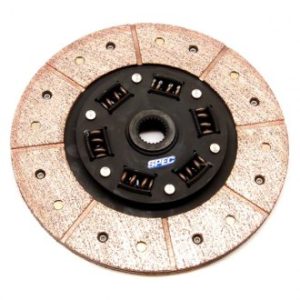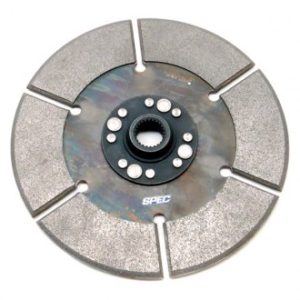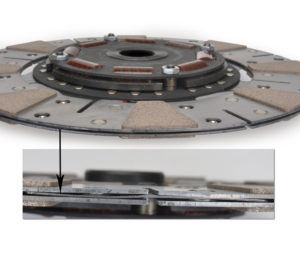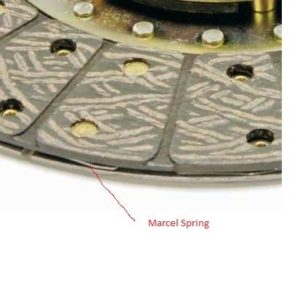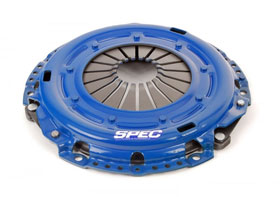When shopping for a clutch the options and features can get overwhelming. Please use the information on this page to aid you in choosing the best options for your car/truck. The first question you need to consider is what your intentions with it are, such as daily driver, drag racing, or towing. There’s several different, designs, styles and features that vary between manufacturers and uses. Some of those include: pressure plate, friction material, and friction disc design. Below are some of the more popular styles and designs but this is in no way a definitive list of options, materials, or designs available today.
How clutches work:
The clutch is what transfers engine power from the crankshaft to the transmission. It consists of a flywheel and pressure plate (PP) which are bolted together with a friction disc sandwiched in between. The flywheel is bolted directly to the crankshaft which means it and the pressure plate are spinning if the engine is running. The friction disc has a splined hub in the center which is attached to the transmissions input shaft. The pressure plate has a machined surface that articulates between the flywheel and front of the transmission. The pressure plate is spring loaded and defaults towards the flywheel with the friction disk in between, on adjustable clutches this is referred to as base pressure. When the clutch pedal is depressed a throw-out bearing will operate levers and moves pressure plate surface away from the flywheel. This allows the pressure plate and flywheel to lose contact with the friction disc thus breaking the linkage between the engine and transmission.
Most users desire a smooth engagement from unlocked to locked. The combination of driving style, friction material, and pressure plate base pressure will dictate how smooth this transition is. An aggressive clutch can create chatter where the materials lock and unlock rapidly. This is not only hard on drive-line parts but can create hot spots leading to premature clutch failure. The optimum combination must maintain the base pressure and coefficient of friction (measurement of friction “grip”) to transfer the engines rotation to the transmission without slipping and maintaining a smooth engagement. The friction from the engagement process build heat which can affect the materials performance. Starting from a stop should be smooth with minimal slip time to avoid “burning” or “glazing” the friction material. Gear shifts especially in racing environments where an extreme load being placed on the clutch during engagement can produce excessive temperatures. The wrong friction material will affect the vehicles performance and clutch life. Pressure plate base pressure and friction material are used to help determine the holding capacity of a given combination.
_________________________________________________________________________
Clutch Friction Materials can easily be compared brake pads. Brake pads offer a variety of materials that react differently when hot vs cold and have carrying rates of wear. Both your brake pads and friction disc use these materials to create friction, some common materials are:
Organic- used in most OEM clutches, has a smooth engagement and very reasonable wear rate. However, it will begin to get “spongy” and slip when hot. This means it’s not recommended for racing where HP/TQ and at their max and quick gear changes build extreme temps.
Kevlar- used in many delivery vehicles and fleet trucks where stop and go driving are common such as FedEx/UPS. Has a smooth engagement and good tolerance to heat. Kevlar wears extremely slow which makes it great for a daily driver/ weekend racer. It also has a greater coefficient of friction than organic material making its holding capacity higher than most stock clutches. Due to its slow wear rate Kevlar clutches have an extended break in period which must be followed. Failure to properly seat the clutch will result in it glazing, once kevlar is glazed it’s can’t be repaired. It’s also a very porous material so it’ll absorb everything that touches it. Once it absorbs grease or oil the material is ruined. Extra attention to cleanliness must be taken to avoid getting grease/oil on the FW, PP, and friction disc.
Semi-Metallic- used in many aftermarket performance clutches, good street manners with more aggressive coefficient of friction than kevlar. Some chatter can happen depending on style of disc it’s attached to. Often mixed with other materials for a hybrid blend such as carbon to increase performance at higher temperatures.
Ceramic- used in mainly race oriented cars due to its aggressive coefficient of friction, has an “on/off” engagement. More prone to chatter depending on disc style and pressure plate. Excellent tolerance for heat but aggressive on flywheel and pressure plate.
Sintered Iron- used primarily in dedicated race vehicles and attached to a solid hub. Designed to be able to slip with the right pressure plate and not glaze. Aggressive grip.
_________________________________________________________________________
Friction disks are usually steel and feature a splined hub which matches the input shaft of the transmission. The friction material is bonded or riveted to the disc in a variety of configurations such as full faced, puck style, or dual friction. Below are some of the most common features and designs:
Full faced- has friction material 360 degrees around the disc. This is the most common style in OEM and aftermarket clutches. It has maximum surface area for grip and minimal chance for chatter since the friction occurs all the way around the disc.
Puck- has friction material in small “pucks” around the perimeter of the disc. The friction material is usually more aggressive allowing there to be less of it while still maintaining the needed holding power. They can vary in numbers from 3-4 pucks and are generally lighter due to less material in the disc. However, they are more prone to chatter than a full-face design due to the small aggressive pucks of friction material.
Dual Friction- has dual friction materials, usually full faced disc. The dual material design allows for an aggressive side and a smoother side resulting in a clutch with more holding power and smooth engagement.
Sprung vs Solid hub- sprung hubs are most common and have a series of coil springs in the hub of the friction disc. This helps absorb shock and smooths engagement by “spring loading” the disc on the transmission shaft. The amount of springs will vary by manufacturer and torque capacity. Stock style will generally have a series of single springs while higher rated discs can have double springs. Solid hubs are just that, a solid disc with friction material attached. This is the strongest design but is more prone to chatter and doesn’t favor smooth engagement. Solid style is primarily used in racing applications.
This is a full faced, sprung hub design
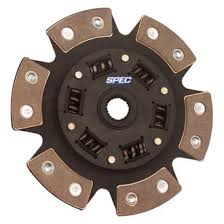
This is a puck style, sprung hub design
This is a solid hub, sintered iron disc
Marcel spring/ wafers- thin crimped plate “wafer” in the disc behind the friction material. This creates a cushion for the friction material against the flywheel and pressure plate. This is a critical piece in reducing chatter. It also helps prevent the friction material from sticking to the pressure plate and flywheel on disengagement. The thicker the marcel the smoother the engagement but the spongier it feels at the pedal. Marcel thickness will vary by manufacturer.
_________________________________________________________________________
Pressure plates can vary by design but work in the same fashion. Most PP’s have a series of fingers or levers that are articulated by a throw out bearing. When engaged the base pressure is fixed. Some PP’s offer weights on the fingers that use centrifugal force to increase the clamp load with RPM thus increasing holding capacity. The amount of weight and their location on the lever determine how much clamp load is increased. In some purpose-built clutches there is an adjustment for base pressure. This is set by adjusting the spring tension inside the PP via adjusting screws. Typically, the base pressure is only adjusted in drag racing setups where there’s a need for a controlled slip to prevent a “dead hook” in the drive-line.
Typical pressure plate
_________________________________________________________________________
Things to remember:
If you’re replacing a clutch but not the flywheel remember to always have your flywheel surfaced before installing the new clutch. Failing to do so will result in premature clutch failure.
When you’re installing your clutch its extremely important to keep the parts clean and free of grease/oil. Clean the surface of the flywheel after bolting it to the crank and do the same for the friction surface of the pressure plate prior to bolting it to the flywheel.
Make sure to progressively tighten you pressure plate bolts in a star pattern, make a few turns and move the the next until all are tight. Always follow the manufacturers torque specifications and never re-use torque to yield (TTY) bolts. If your application has TTY bolts we’d be happy to get you some re-usable ARP bolts.
Always follow the manufactures specified seating and break in procedures, not doing so will cause clutch failure and void any warranty.

